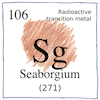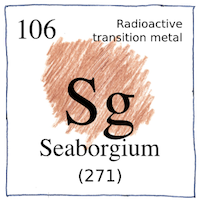Berkeley—Albert Ghiorso,
Joachim Michael Nitschke,
José R. Alonso,
Carol T. Alonso,
Matti Nurmia,
Glenn T. Seaborg,
E. Kenneth Hulet,
Ronald W. Lougheed
elements

|
Seaborgium
The Soviets synthesized element 106, by bombarding lead with chromium ions. The Americans synthesized it by bombarding californium with oxygen ions. Nobody synthesized more than a few atoms that lasted more than a second. But the Americans had better data and analyses, so they got to name it after Glenn T. Seaborg.
Atomic number 106
Attempting to gather enough Seaborgium to measure its density would be impractical. Attempting to test its oxydation states, when producing one quickly-decaying atom at a time, would be difficult. Ionization energies, reduction potentials, atomic radius, covalent radius, and crystal structure are only predicted or estimated.
Unnilhexium
We had a name for it before we saw its face. Not Baby number 106. Its mother was not present at the birth. Not John Doe 106. No need to protect its identity. It took twenty years for the official committee to let it be named after a person who was still living. Whatchamacallit? Element 106. Hey you!



Is the distinction between the identity and the identifier blurred when we complain about identify theft, or is one’s identity in the modern world too much invested in intangibles?
See also in The book of science:
Readings in wikipedia:
Other readings: